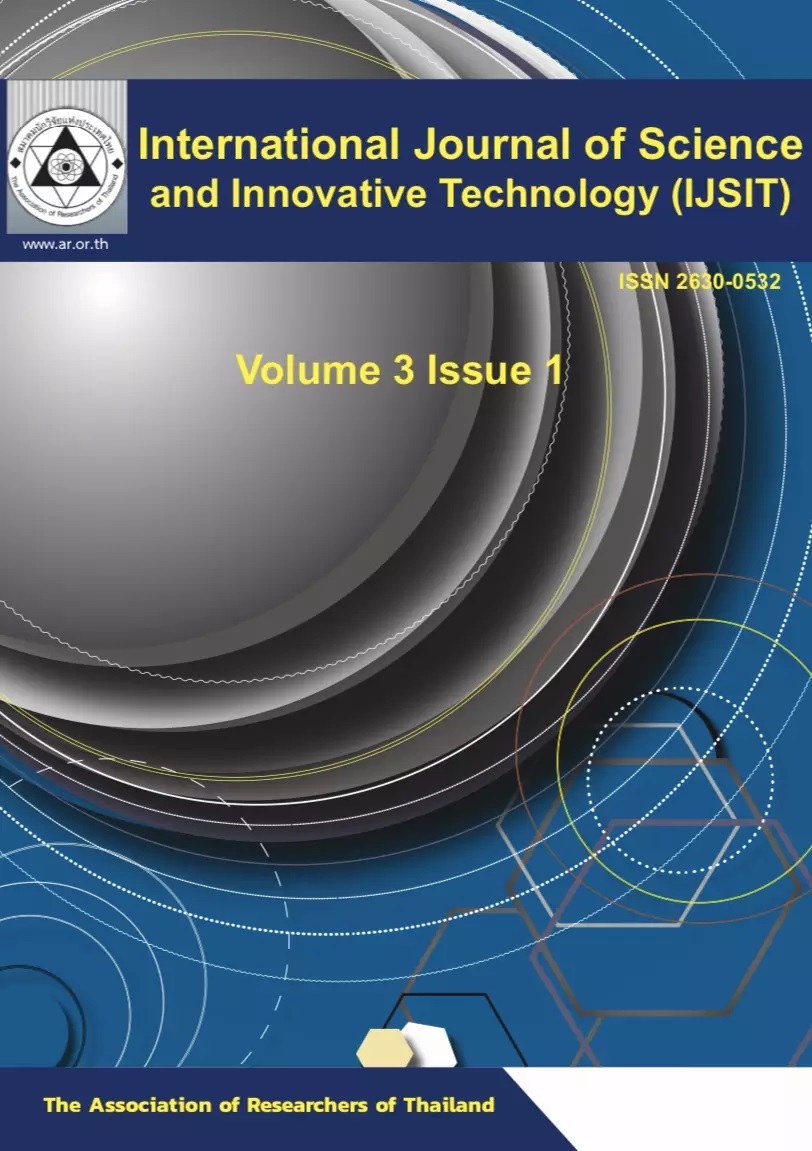Investigation of Physical and Mechanical Properties of Colored TiO2 Thin Films deposited by RF Magnetron Sputtering
Main Article Content
Abstract
The colored titanium dioxide (TiO2) thin films were prepared by RF magnetron sputtering technique using purity TiO2 target. In this study, the deposition time for sputtering process was varied from 60, 75, 90, 105 and 120 minutes by using the fixed appropriate sputtering power at 100 W. The working pressure of argon gas was kept constant at 6.0x10-1 Pa. As a consequence, TiO2 thin films were deposited on both glass and stainless steel substrates for color’s film observation. To study the physical and mechanical properties of colored TiO2 thin films, optical transmission, surface morphology and structure were investigated by using UV-Vis Spectrophotometer, FESEM and XRD, thin film thickness and adhesion were measured by calotester and micro scratch tester, respectively. It was found that the colored TiO2 thin films were clearly observed on both substrates. The optical transmission for TiO2 films showed highly transmission in the visible regions and surface morphologies showed nano-scale grain size and smooth surface. The structure of all TiO2 thin films exhibited amorphous structure. For these results, thicknesses of colored TiO2 thin films are approximately 70 nm to 150 nm. In addition, the adhesion of colored films performed a good adhesion by increasing deposition time.
Article Details
References
[2] Zahedi, F., Behpour, M., Ghoreish, S. M. and Khalilia, H. (2015). Photocatalytic degradation of paraquat herbicide in the presence TiO2 nanostructure thin films under visible and sun light irradiation using continuous flow photoreactor. Solar Energy, 120, 287–295.
[3] Salman, S. H., Shihab, A. A. and Elttayef, A. – HK. (2019). Design and construction of Nanostructure TiO2 thin film gas sensor prepared by R.F magnetron sputtering technique. Energy Procedia, 157, 283-289.
[4] Xiong, Y., Lai, M., Li, J., Yong, H., Qian, H., Xu, C., Zhong, K. and Xiao, S. (2015). Facile synthesis of ultra-smooth and transparent TiO2 thin films with superhydrophilicity. Surface and Coatings technology, 265, 78-82.
[5] Bharti, B., Kumar, S. and Kumar, R. (2016). Superhydrophilic TiO2 thin film by nanometer scale surface roughness and dangling bonds. Applied Surface Science, 364, 51-60.
[6] Gao, Z., Zhai, X., Liu, F., Zhang, M., Zang, D. and Wang, C. (2015). Fabrication of TiO2/EP superhydrophobic thin film on filter paper surface. Carbohydrate Polymers, 128, 24-31.
[7] Momeni, M. Golestani-Fard, F., Saghafian, H., Barati, N. and Khanahmadi, A. (2015). Development of visible light activated TiO2 thin films on stainless steel via sol spraying with emphasis on microstructural evolution and photocatalytic activity. Applied Surface Science, 357, part B, 1902-1910.
[8] Jiang, Y., Shi, K., Tang, H. and Wang, Y. (2019). Enhanced wettability and wear resistance on TiO2/PDA thin films prepared by sol-gel dip coating. Surface and Coatings Technology, 375, 334-340.
[9] Meher, S.R. and Balakrishnan, L. (2014). Sol–gel derived nanocrystalline TiO2 thin films: A promising candidate for self-cleaning smart window applications. Materials Science in Semiconductor Processing, 26, 251–258.
[10] Zhang, Z., Wong, L. M., Zhang, Z., Wu, Z., Wang, S., Chi, D., Hong, R. and Yang, W. (2015). Pulse laser deposition of epitaxial TiO2 thin films for high-performance ultraviolet photodetectors. Applied Surface Science, 355, 398–402.
[11] Ishii, A., Nakamura, Y., Oikawa, I., Kamegawa, A. and Takamura, H. (2015). Low-temperature preparation of high-n TiO2 thin film on glass by pulsed laser deposition. Applied Surface Science, 347, 528–534.
[12] Astinchap, B. and Laelabadi, K. G. (2019). Effects of substrate temperature and precursor amount on optical properties and microstructure of CVD deposited amorphous TiO2 thin films. Journal of Physics and Chemistry of Solids, 129, 217-226.
[13] Guillén, C. and Herrero, J. (2017). TiO2 coatings obtained by reactive sputtering at room temperature: Physical properties as a function of the sputtering pressure and film thickness. Thin Solid Films, 636, 193–199.
[14] Nezar, S., Saoula, N., Sali, S., Faiz, M., Mekki, M., Laoufi, N. A. and Tabet, N. (2017). Properties of TiO2 thin films deposited by rf reactive magnetron sputtering on biased substrates. Applied Surface Science, 395, 172–179.
[15] Neugebohrn, N., Gehrke, K., Brucke, K., Götz, M. and Vehse, M. (2019). Multifunctional metal oxide electrodes: Colour for thin film solar cells. Thin Solid Films, 685, 131–135.
[16] Niyomsoan, S., Grant, W., Olson, D. L. and Mishra, B. (2002). Variation of color in titanium and zirconium nitride decorative thin films. Thin Solid Films, 415, 187-194.
[17] Panjan, M., Klanjšek Gunde, M., Panjan, P. and čekada, M. (2014). Designing the color of AlTiN hard coating through interference effect. Surface and Coatings Technology, 254, 65-72.
[18] Mercier, D., Mandrillon, V., Parry, G., Verdier, M., Estevez, R., Bréchet, Y. and Maindron, T. (2017). Investigation of the fracture of very thin amorphous alumina film during spherical nanoindentation. Thin Solid Films, 638, 34–47.
[19] Zivica, F., Babic, M., Adamovic, D., Mitrovic, S., Todorovi, P., Favaro, G. and Pantic, M. (2012). Influence of the surface roughness on adhesion of chrome coatings on alloy tool steel X165CrMoV12. Journal of the Balkan Tribological Association, 18(2), 228–237.


